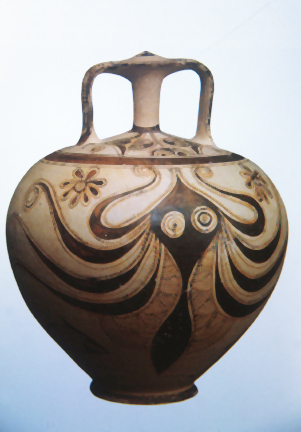
Stirrup octopus vase, Mycenaean
1200-1100 BCE
ART 198 - HISTORY OF WORLD CERAMICS
| After the waning of influence of the Minoan culture, the center of power shifted to mainland Greece and the city of Mycenae around 1400 BCE. The Mycenaeans produced technically accomplished pottery using the wheel and polychrome slip painting. Subject matter often echoed that of the Minoan culture, as in this piece with a stylized octopus and other marine motifs. Note, however, that designs do not flow around the form, but rather are contained within defined bands of pattern. Mycenaean burials were usually in 'shaft' tombs, vertical excavations that were successively filled with the remains and treasures of noble families. Some of these shaft tombs have yielded examples of gold and silver work of unrivaled quality as well as ceramics. The city of Mycenae was heavily walled and fortified against invasion, but after only 300 years, the city fell to incursions of barbarians to the north, and a kind of 'dark age' settled across the Greek mainland for several hundred years. | Stirrup octopus vase, Mycenaean 1200-1100 BCE |
|
|